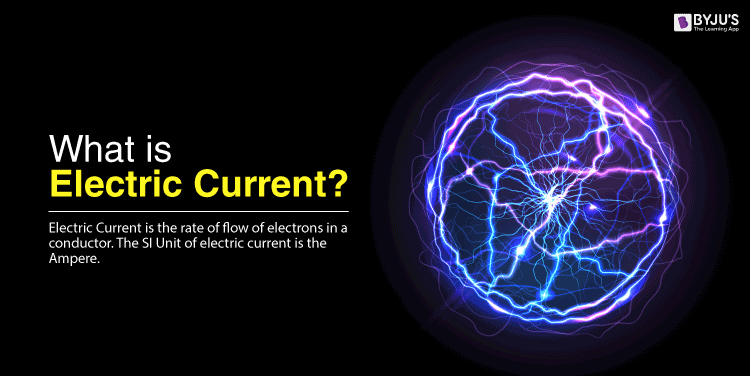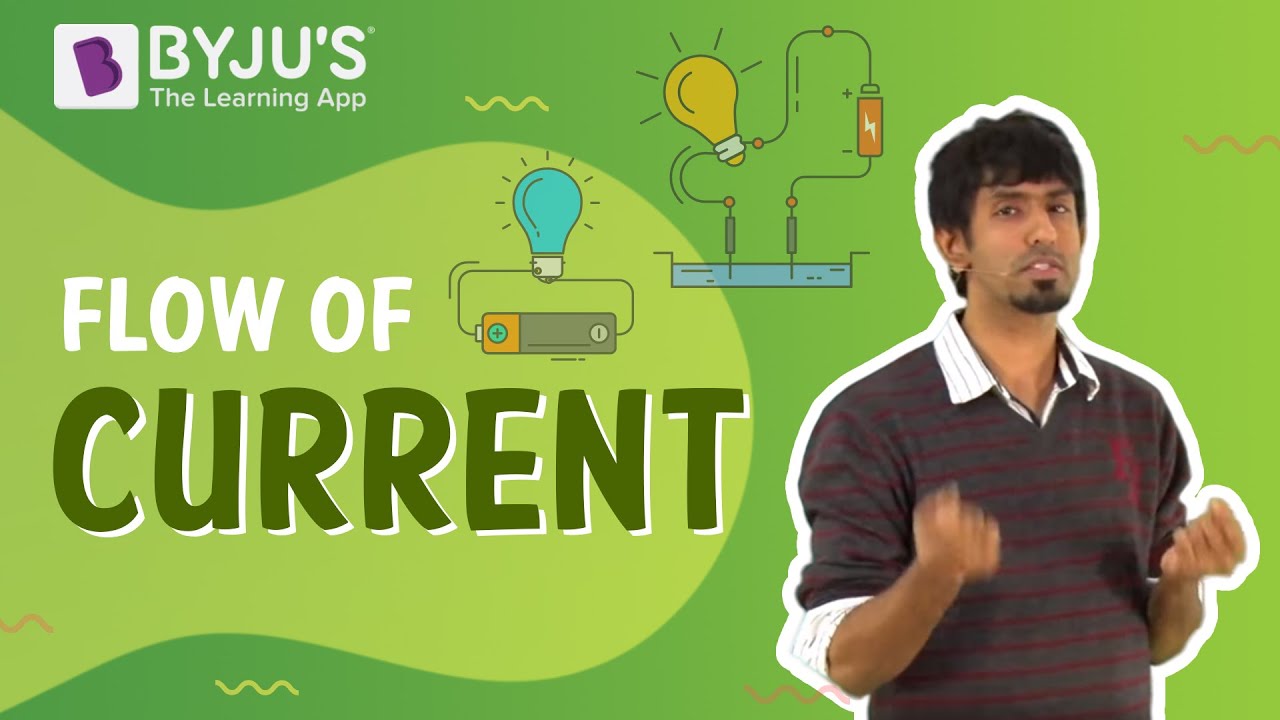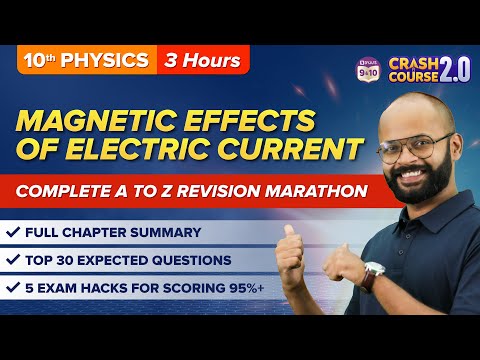Our ancestors relied on fire for light, warmth and cooking. Today at the flick of a switch, turn of a knob or the push of a button, we have instant power. This is possible because of the electric current. Do you know what is current? In this article, let us learn and find how electric current has revolutionised modern-day living. It is one of the important discoveries that helped us transform our way of living. From the time we wake up till the time we sleep at night, our life is dependent on electricity. From the basic bread toaster and baking oven to the commonly used television all require electric current to operate. The most common device, mobile phones, uses the electric current to charge the battery for operation. Besides playing a major part at home, electricity also plays an important role in industries, transportation and communication. In this article, let us learn to define electric current as an important resource that we are highly dependent on.
Electric Current Definition
Let us now define electric current and also know about conductors and insulators.

Electric Current is the rate of flow of electrons in a conductor. The SI Unit of electric current is the Ampere.
Electrons are minute particles that exist within the molecular structure of a substance. Sometimes, these electrons are tightly held, and other times they are loosely held. When electrons are loosely held by the nucleus, they are able to travel freely within the limits of the body. Electrons are negatively charged particles hence when they move, a number of charges moves, and we call this movement of electrons as electric current. It should be noted that the number of electrons that are able to move governs the ability of a particular substance to conduct electricity. Some materials allow the current to move better than others. Based on the ability of the material to conduct electricity, materials are classified into conductors and insulators.
Conductors: these materials allow the free flow of electrons from one particle to another. Conductors allow for charge transfer through the free movement of electrons. The flow of electrons inside the conducting material or conductor generates an electric current. The force that is required to drive the current flow through the conductor is known as voltage.
Examples of conductors: Human body, aqueous solutions of salts and metals like iron, silver and gold.
Did You Know?
Silver is the best conductor of electricity.
Insulators: Insulators are materials that restrict the free flow of electrons from one particle to another. The particles of the insulator do not allow the free flow of electrons; subsequently, the charge is seldom distributed evenly across the surface of an insulator.
Examples of Insulators: Plastic, Wood and Glass
Prerequisites for the Current to Flow in a Conductor
Some of the prerequisites for the electric current to flow in a conductor are discussed here. The circuit includes an energy source (a battery, for instance) that produces voltage. Without voltage, electrons move randomly and are undirected; hence current cannot flow. Voltage creates pressure on the electrons, which channelises them to flow in a single direction.
The circuit forms a closed conducting loop through which electrons can flow. A circuit is said to be closed or complete when a switch is turned ON.
What Is an Electromotive Force?
The motion of free electrons is normally haphazard. If a force acts on electrons to make them move in a particular direction, then up to some extent random motion of the electrons will be eliminated. An overall movement in one direction is achieved. The force that acts on the electrons to make them move in a certain direction is known as electromotive force, and its quantity is known as voltage and is measured in volts.
Read More: Electromotive Force
Unit of Electric Current
Let us know what is current and the unit to measure it.
The magnitude of electric current is measured in coulombs per second. The SI unit of electric current is Ampere and is denoted by the letter A. Ampere is defined as one coulomb of charge moving past a point in one second. If there are 6.241 x 1018 electrons flowing through our frame in one second, then the electrical current flowing through it is ‘One Ampere.’
The unit Ampere is widely used within electrical and electronic technology along with the multipliers like milliamp (0.001A), microamp (0.000001A), and so forth.
Read More: Ampere
Visualising Electric Current
To gain a deeper understanding of what an electric current is and how it behaves in a conductor, we can use the water pipe analogy of electricity. Certainly, there are some limitations but they serve as a very basic illustration of current and current flow.

Water Pipe Analogy of Electricity
We can compare the electric current to the water flowing through the pipe. When pressure is applied to one end of the pipe, the water is forced to flow through the pipe in one direction. The amount of water flow is proportional to the pressure placed on the end. This pressure can be compared to the electromotive force.
Conventional Current flow Vs Electron Flow
There is a lot of confusion around conventional current flow and electron flow. In this section, let us understand their differences.

Conventional Current Flow vs Electron Flow
Conventional Current Flow
The conventional current flow is from the positive to the negative terminal and indicates the direction in which positive charges would flow.
Electron Flow
The electron flow is from negative to positive terminal. Electrons are negatively charged and are therefore attracted to the positive terminal as unlike charges attract.
Properties of Electric Current
After we define electric current, let us learn the properties of electric current. Electric current is an important quantity in electronic circuits. We have adapted electricity in our lives so much that it becomes impossible to imagine life without it. Therefore, it is important to know what is current and the properties of the electric current.
- We know that electric current is the result of the flow of electrons. The work done in moving the electron stream is known as electrical energy. Electrical energy can be converted into other forms of energy such as heat energy, light energy, etc. For example, in an iron box, electric energy is converted to heat energy. Likewise, the electric energy in a bulb is converted into light energy.
- There are two types of electric current known as alternating current (AC) and direct current (DC). The direct current can flow only in one direction, whereas the alternating direction flows in two directions. Direct current is seldom used as a primary energy source in industries. It is mostly used in low voltage applications such as charging batteries, aircraft applications, etc. Alternating current is used to operate appliances for both household and industrial and commercial use.
- The electric current is measured in ampere. One ampere of current represents one coulomb of electric charge moving past a specific point in one second.
- The conventional direction of an electric current is the direction in which a positive charge would move. Henceforth, the current flowing in the external circuit is directed away from the positive terminal and toward the negative terminal of the battery.
You shouldn’t touch electrical equipment with wet hands! Watch the video to know why?

Effects of Electric Current
After defining electric current, let us learn various effects of electric current. When a current flows through a conductor, there are a number of signs which tell if a current is flowing or not. Following are the most prominent signs:
Heating Effect of Electric Current
When our clothes are crumpled, we use the iron box to make our clothes crisp and neat. Iron box works on the principle of heating effect of current. There are many such devices that work on the heating effect.
When an electric current flows through a conductor, heat is generated in the conductor.
The heating effect is given by the following equation
H=I2RT
The heating effect depends on the following factor:
- The time ‘t‘ for which the current flows. The longer the current flows in a conductor more heat is generated.
- The electrical resistance of the conductor. Higher the resistance, the higher the heat produced.
- The amount of current. The larger the amount of current higher the heat produced.
If the current is small then the amount of heat generated is likely to be very small and may not be noticed. However, if the current is larger then it is possible that a noticeable amount of heat is generated.
Read More: Heating Effect of Electric Current
Magnetic Effect of Electric Current
Another prominent effect that is noticeable when an electric current flows through the conductor is the build-up of the magnetic field. We can observe this when we place a compass close to a wire carrying a reasonably large direct current, and the compass needle deflects. The magnetic field generated by a current is put to good use in a number of areas. By winding a wire into a coil, the effect can be increased, and an electromagnet can be made.
Read More: Magnetic Effect of Electric Current
Chemical Effect of Electric Current
When an electric current passes through a solution, the solution ionizes and breaks down into ions. This is because a chemical reaction takes place when an electric current passes through the solution. Depending on the nature of the solution and the electrodes used, the following effects can be observed in the solution:
- change in the colour of the solution
- metallic deposits on the electrodes
- a release of gas or production of bubbles in the solution
Electroplating and electrolysis are the applications of the chemical effect of electric current.
Read More: Electroplating and Electrolysis
The below videos help to revise the chapter Electricity Class 10
 |
 |
Frequently Asked Questions – FAQs
Why are copper wires used as connecting wires?
Because they offer low resistivity for the flow of electrons.
What is the reciprocal of conductance?
Resistance is the reciprocal of conductance.
What happens to the resistance of pure metals and semiconductors with an increase in temperature?
The resistance of pure metals increases with the increase in temperature, and the resistance of semiconductors decreases with an increase in temperature.
What is the unit of electric conductivity?
mho/metre or Siemens/metre.
Which method is used for the absolute measurement of resistance?
The Wheatstone bridge method is used for the absolute measurement of resistance.
What are insulators?
Define ampere.
What is electromotive force?
What is an electric charge?
State Coulomb’s law.
The below video helps to revise the chapter Magnetic Effects of Electric Current

Stay tuned with BYJU’S for more such interesting articles. Also, register to “BYJU’S – The Learning App” for loads of interactive, engaging Physics-related videos and unlimited academic assistance.

Sir I am appreciate from your perceptions about as per students need in their lesson . you have given each and every information about the lesson. Thank you. !
Thankyou for your detailed explanation about the Electric current chapter and also for extra points.
nice explanation information
This is great explanation of Electric current